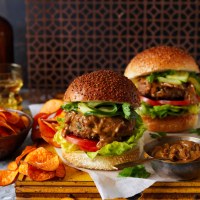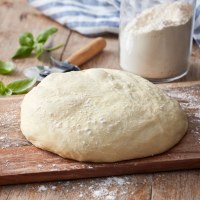The secrets to juicy burgers
A classic Aussie-style burger patty is thick, has a flavourful brown crust and is juicy and tender all the way through. So how do you get a good seared burger without drying out the insides? These secrets will help you achieve flavourful and moist burgers at home!
The best meat for burger patties
Beef and lamb
For beef and lamb burgers, choose mince that has at least an 80% meat to 20% fat ratio. The fat is essential for juiciness and flavour. If you can’t find mince with the right ratio, add finely chopped streaky bacon to your patty mixture. You can also use half your chosen mince and substitute the other half with pork mince.
If you’re grinding your own mince for burgers, choose a meat that has about the same ratio of meat and fat. Highly marbled cuts such as chuck steak are perfect for this. Process or mince to the coarseness you desire.
Chicken and turkey
Minced chicken or turkey burgers can be very dry if cooked on their own. Choose mince that is from the leg meat. The meat from these cuts has more fat, and it’s therefore more flavourful and moist. You can also add finely chopped bacon to increase that juicy texture.
Otherwise, using whole breast or thigh cuts of chicken instead of using mince can give you a juicier result.
Fish
If you're grilling your fish to use in a burger, choose a nice thick fillet from a larger fish such as barramundi, blue-eye cod, snapper or ling. These will give you a nice meaty and moist bite. Fish like hake and basa have a low fat content, and won't grill well for a burger - to enjoy in a burger, try battering and frying them instead.
In all cases, avoid using lean mince as it will have a tendency to dry out. Unless of course you’re making a healthy burger, in which case one of the tips below might help out.
Juicy burger Dos and Don'ts
DO: Add extra flavour and moisture by adding your favourite sauces or curry pastes. Try adding a couple of tablespoons of either tomato sauce, barbecue sauce, oyster sauce or korma curry paste.
DO: Eggs are also a great way of adding fat and extra flavour. It serves a double purpose of helping to bind the meat and other ingredients together too…no crumbly meat patties!
DO: Try adding some cheese directly to the burger mince. Grated cheddar, low moisture mozzarella or crumbled feta will all add fat and flavour to the patty. Just be careful, as cheese can also make the patties brown much faster.
DON'T: Overmix your burger patty mix. Only mix as much as you need to just combine all the ingredients. Overworking the mince will make your patty firm and bouncy instead of tender and juicy.
DON'T: Add salt to your meat patties before cooking. Instead, season one side just before you put it in the pan, and season the other once it’s in. Adding salt to all of the burger mixture will dry out your patties while they are cooking.
The best way to form meat patties
Form your meat patties just so - they should not be too thick or thin. Much like a steak, they need to be thick enough to brown on the outside without overcooking and drying out the insides. They’re best when they’re around 1½ cm thick.
Scoop out a ball of mince around 150g and roll into a ball. Flatten to your desired thickness and ensure it’s just a bit larger than your burger buns as it will shrink a little. Make a small divot into the centre of the burger. This will prevent the patty from shrinking too much.
How to cook juicy burger patties
- Preheat a frying pan over medium-high heat. Allow it to get very hot before adding the meat. Use vegetable oil as it has a high smoke point. The patties should sizzle when they hit the pan, and when flipped, you should see a nicely dark, golden-brown sear on the underside.
- Cook for around 3-4 minutes on each side. Moving the patties as they cook will disturb the formation of the crust, so don’t touch them until you flip them. Adding a divot into the centre of the patty will help stop shrinkage, so you don’t need to squash the patties while they’re in the pan.
- Cook till three-quarters done, then move to a plate to rest and finish cooking with residual heat. This will stop the meat from drying out.
Burger recipes
Now you have all the top tips to become a budding burger chef, it's time to have a burger night with the burger recipes below!
GET THE RECIPE: Lamb Korma Burgers with Onion Curry Sauce by Passage to India
















